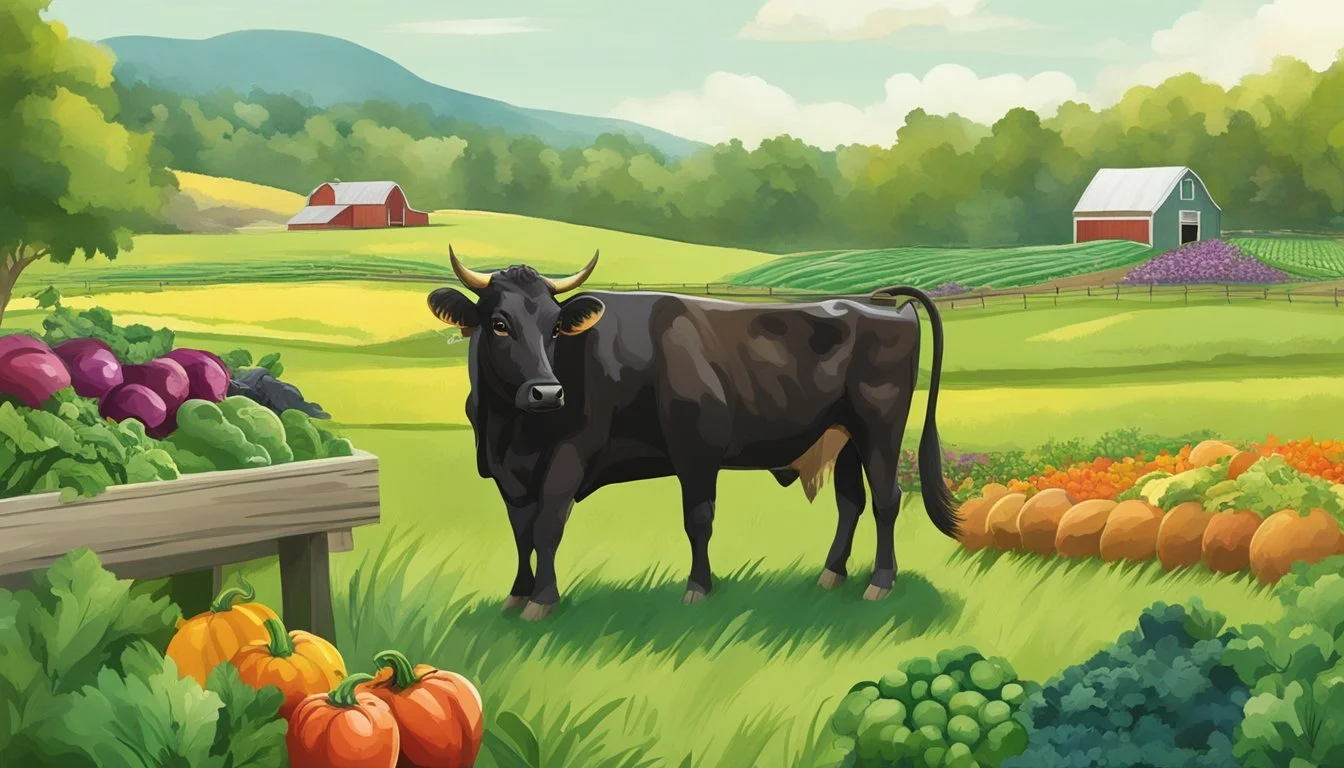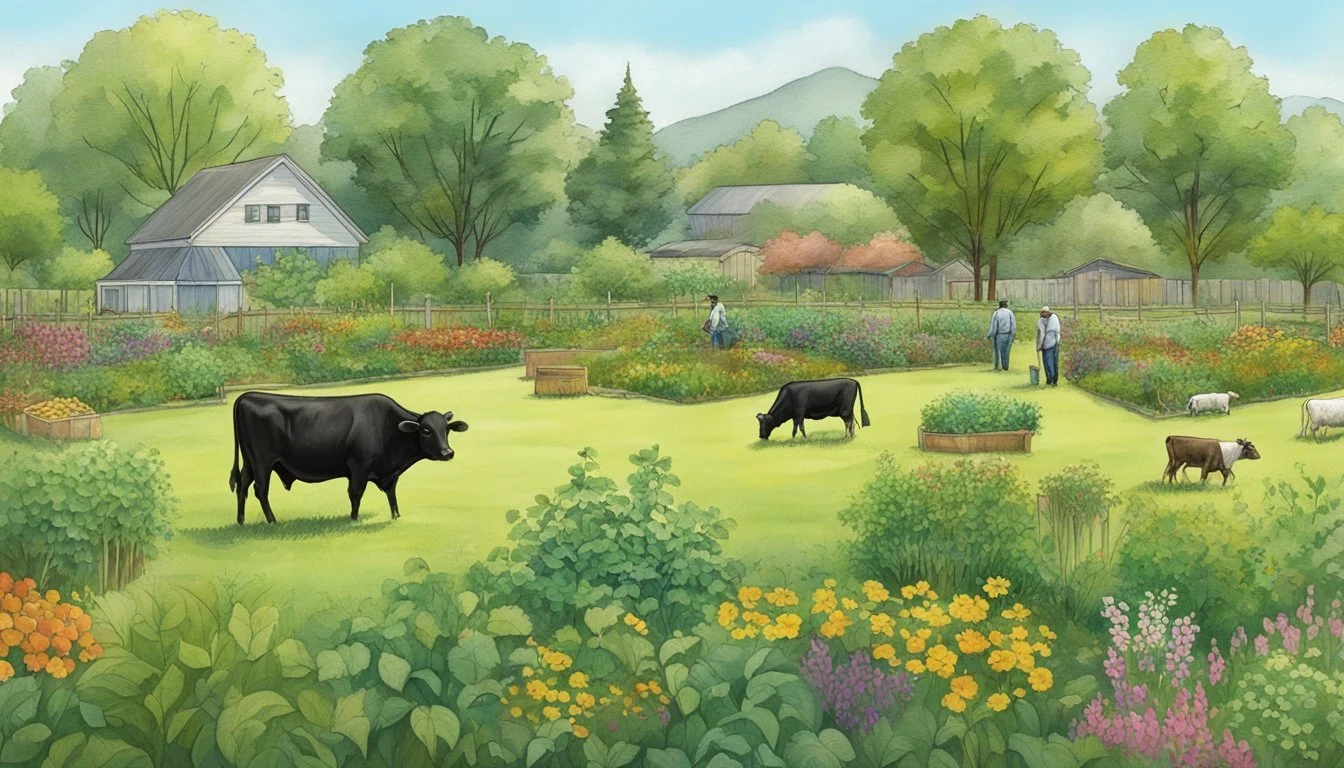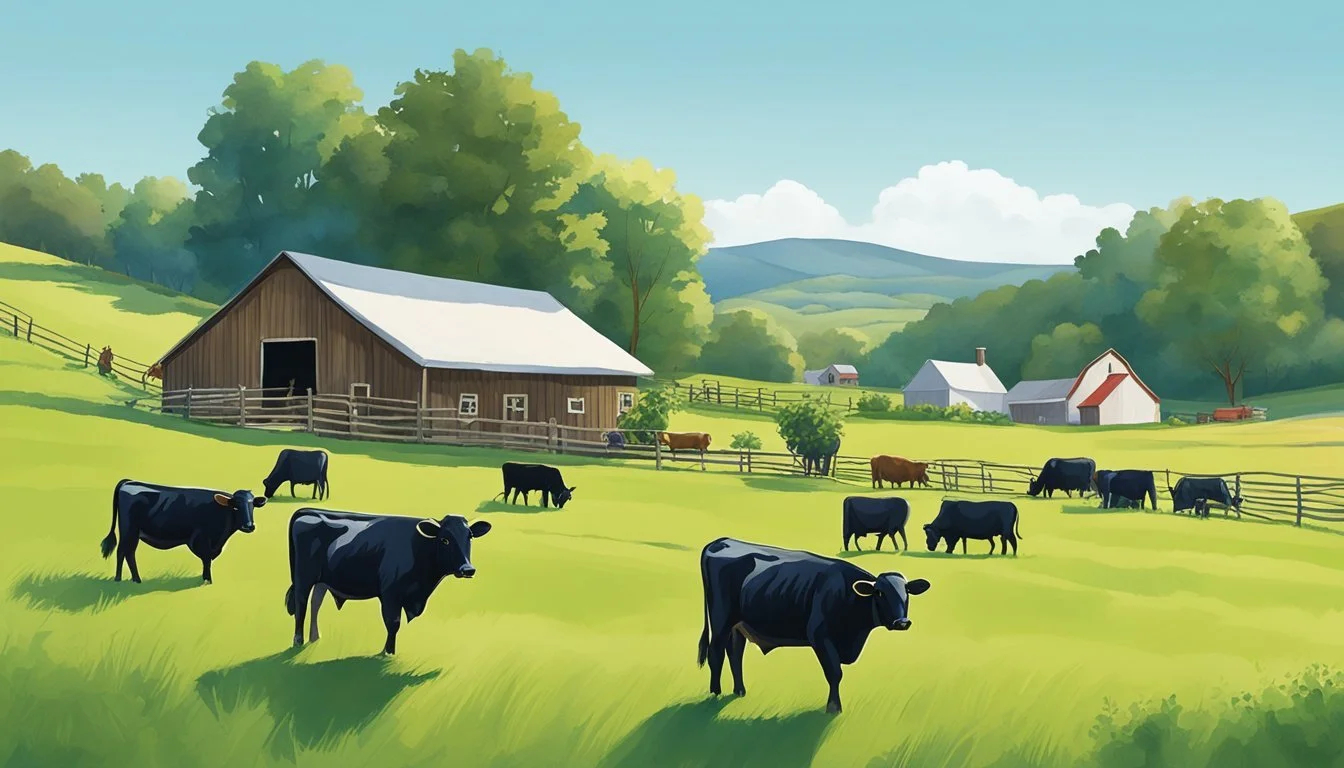The Role of Dexter Cattle in Enhancing Community Supported Agriculture Efficacy
The role of Dexter Cattle in Community Supported Agriculture (CSA) initiatives marks an innovative intersection of sustainable agriculture and consumer involvement. CSAs are a framework where consumers directly support local farmers by purchasing a portion of the season's harvest in advance. This agricultural model not only secures a market for the farmers but also fosters community engagement and a deeper understanding of food production among consumers. At the heart of this partnership is the shared commitment to ecological stewardship and the promotion of local economies.
Dexter Cattle, a heritage breed known for its smaller size and versatility, complements the ethos of CSAs by providing a source of high-quality meat with a more manageable impact on the land. These cattle are often grass-fed and grass-finished, appealing to consumers seeking not just organic meat but also transparency in their food's lifecycle. In addition, Dexter Cattle require less pasture space, produce less waste, and are easier to handle than larger breeds, making them a practical and sustainable choice for CSA farmers focused on enhancing biodiversity and minimizing their carbon footprint.
Incorporating livestock into CSA models expands the traditional focus on produce to include a range of animal products, thereby enriching the diversity of local food systems. Dexter Cattle operations within a CSA framework embody this progress, meeting the growing consumer demand for responsible farming practices and creating a robust, resilient local food supply. The integration of these cattle into CSAs showcases a forward-thinking approach to agriculture that benefits both the local environment and the community it serves.
History and Principles of CSA
Community Supported Agriculture (CSA) represents a holistic approach to the relationship between consumers and their food sources, involving trust and participation from community members.
Origins of the CSA Model
Community Supported Agriculture emerged as a concept to strengthen the consumer-farmer relationship. In the United States, the inception of CSA is often credited to European influence, with two notable farms, Indian Line CSA and Temple-Wilton Community Farm, being established in 1986. These farms may not have been the first to employ CSA principles in America, but they were pivotal in refining and popularizing the model.
Key Concepts and Values
At its core, CSA is based on several fundamental principles:
Cooperation: Members invest in the farm by purchasing shares of the anticipated harvest, sharing both the risks and the rewards.
Sustainability: The model encourages environmentally friendly farming practices and seeks to secure the economic viability of small farms.
Community Engagement: CSAs often include member participation in some aspects of farm operation, fostering a strong connection to the food and the land.
Robyn Van En and the CSA Movement
Robyn Van En was instrumental in cultivating the CSA Movement within the United States. She co-founded the Indian Line Farm in 1986 and was a key figure in spreading the CSA concept through her pamphlet "Basic Formula to Create Community Supported Agriculture", which also popularized the term "CSA". Van En's dedication to the cause significantly influenced the growth of the CSA Movement, advocating for communal support and trust in local agriculture.
Through these subsections, the overall integrity and continuity of the CSA ideology are upheld, focusing on community participation, shared risk, and the promotion of sustainable agriculture.
Understanding Dexter Cattle
Dexter cattle serve as a sustainable choice for smaller-scale agricultural endeavors, providing both high-quality milk and meat.
Characteristics of Dexter Cattle
Origin: Dexter cattle hail from Ireland. As a breed, they exhibit a small stature with adults typically weighing 700-750 pounds. The breed presents with a broad body and can have either short or long legs. Dexter cattle possess well-rounded hindquarters and a solid, compact build.
Appearance: Their coloration includes predominantly black, but also dun and red variants are found. Initially, Dexters were horned, although many lines have been bred to be naturally polled.
Climate Adaptability: Dexter cattle are known for their versatility and hardiness, capable of thriving in varying climates.
Breed Advantages for Small Farms
Size: Due to their smaller size, Dexter cattle can be an especially good fit for small land holdings or community supported agriculture (CSA) programs. Their size allows them to be more easily managed and requires less space compared to larger breeds.
Foraging Efficiency: They are efficient foragers, often thriving on pasture-based diets, which can contribute positively to sustainable agriculture practices.
Dual-Purpose Contribution: Dexter cattle are dual-purpose animals, providing both milk and beef. Their milk is rich and their meat is of high quality, attracting smaller farms looking to offer diverse products to their CSA shareholders.
Temperament: They generally have gentle dispositions, making them a suitable addition to farms with varied audiences, including families and educational groups involved in CSA programs.
By integrating into CSAs, Dexter cattle can fulfill multiple roles, thereby supporting a more sustainable and community-oriented approach to small-scale farming.
Dexter Cattle in CSA Operations
Dexter cattle offer distinct advantages in Community Supported Agriculture due to their versatility and smaller stature. They contribute to sustainable agriculture practices, are well-suited for organic farming, and their outputs support the economic model of CSA farms.
Grazing and Land Management
Dexter cattle are an efficient choice for CSA farms focusing on sustainable land management. They are smaller than many beef breeds and are known for their lighter impact on pastureland. This gentler grazing promotes better grass regrowth and reduces soil compaction. Their ability to thrive on less acreage makes them ideal for the limited space of small-scale farms typically associated with CSA. Dexter cattle's grazing habits are not only beneficial for land management but also support the sustainable agriculture ethos of CSA by fostering healthier pastures.
Milk and Meat Production
When it comes to meat production, Dexter cattle's carcasses yield a high meat-to-bone ratio despite their small size, producing quality cuts that are lean and well-marbled. Their meat is a draw for CSA members who appreciate grass-fed beef's health benefits. Additionally, Dexter cattle are dual-purpose; they can be milked, producing a rich milk with a higher butterfat content than many standard dairy breeds. For CSA farms, this means a single breed can provide both dairy and meat, increasing the variety of products offered to their subscribers.
Dexter Cattle and Organic Farming
Tied closely to organic farming, Dexter cattle can be raised without the use of synthetic feeds or antibiotics, comporting with organic standards. Their endurance and adaptability are conducive to organic practices, which emphasize animal health and welfare as well as environmental sustainability. By integrating Dexters into an organic farming approach, CSA operations can maintain a closed-system farm model: the farm produces the feed, and the cattle contribute to the farm's overall fertility through their manure, illustrating an excellent example of a sustainable agricultural practice in which resources are recycled and the ecological footprint minimized.
Economic Implications of Dexter Cattle
In the context of Community Supported Agriculture (CSA), Dexter cattle present distinct economic implications. These small-framed livestock can influence both the expenses and income of a CSA farm through their versatility in producing meat and milk.
Costs and Revenue Streams
Dexter cattle, originating from Ireland, exhibit a smaller stature, leading to reduced feed costs compared to larger breeds. Their hardiness and adaptability can lower veterinary expenses, as these animals often display strong disease resistance. CSA operations must account for:
Initial Investment: Purchase price of Dexter cattle and infrastructure setup.
Ongoing Costs: Feed, healthcare, and labor.
Dexter cattle contribute to multiple revenue streams for CSA farms:
Meat Production: They mature early, offering a quicker turnaround on investment.
Milk Sales: Dexter milk yields are favorable, and the milk—missing A1 protein—can cater to niche markets.
Breeding Programs: Selling calves or offering breeding services adds income diversity.
CSA farmers may apply for grants and subsidies from the U.S. Department of Agriculture (USDA) to help offset some of these costs.
Comparison with Other Livestock in CSA
When compared to other livestock, Dexters requisition less land, aligning with the smaller-scale nature of most CSAs. Herds under 50 Dexters align with these figures and can be sustainable with proper management and market positioning. CSA programs can attract consumers by participating in sustainable, small-scale local food systems—Dexter cattle can be an integral part of this process.
Land Utilization: Smaller breeds like Dexters typically require less acreage than larger cattle, optimizing space in CSA settings.
Consumer Attraction: Dexters fit the CSA model that values local, sustainable practices, possibly leading to a loyal consumer share.
Wages and Labor: Since Dexters are manageable and less resource-intensive, they may reduce labor requirements and associated wages.
Understanding the balance between costs and potential earnings with Dexter cattle helps determine their fit in a CSA's budget and ethos.
Community Engagement and CSA
Community Supported Agriculture (CSA) is not just a method of food distribution, but also a platform for member education and community networking. It fosters a sense of community through direct engagement, thereby strengthening local food systems.
Member Involvement and Education
In Community Supported Agriculture, member involvement is central to its success. Members typically contribute by upfront payments, securing a harvest share, and often participating in farm activities. They are educated on sustainable practices and learn about the origin of their food, which reinforces their local food knowledge.
Orientation sessions: Many CSAs hold educational meetings for members.
Workshops: Skills in organic farming and livestock care are shared.
Newsletters: Regular updates about farm progress and member responsibilities are provided.
Through these avenues, CSAs enhance their membership's understanding of food production, fostering informed consumption choices.
Building Community Networks
CSAs serve as a cornerstone for building community networks, connecting people with mutual benefit and often leading to lasting friendships. They leverage local networks to distribute food and share resources.
Local partnerships: Connections with regional food cooperatives and businesses.
Community events: Regular social gatherings to encourage community bonding and collaborative decision-making processes.
Such networks are not only vital for CSA viability but also for creating resilient local food systems that are supported by a committed community base.
Environmental Impact of Dexter Cattle
Dexter cattle play a distinctive role within the framework of Community Supported Agriculture (CSA) due to their environmental adaptability and potential benefits in terms of sustainability and response to climate change.
Sustainability and Climate Change
Dexter cattle exhibit several characteristics that position them favorably in conversations about sustainability and their impact on climate change. Their small size and hardiness make them less resource-intensive compared to larger cattle breeds. They require less pasture and can be managed effectively on smaller parcels of land, which is conducive to the CSA model where efficiency and local food production are paramount.
Resource Efficiency: Dexters consume less fodder due to their size, translating to a lesser environmental footprint per animal.
Hardiness: Their ability to thrive in varied climates reduces the need for additional inputs like housing and feed that can drive up greenhouse gas emissions.
The breed's qualities also align with the goals of the Environmental Protection Agency (EPA) to reduce methane emissions from livestock. Methane, a potent greenhouse gas contributing to climate change, is a natural byproduct of cattle digestion. Dexter cattle's efficient feed-to-weight gain ratio suggests that they may produce less methane per kilogram of beef compared to larger breeds.
It's important to note that while Dexter cattle have a lower impact per animal, the overall sustainability of beef production also depends on practices like rotational grazing and the integration of livestock into diverse agricultural systems, which can further mitigate negative environmental outcomes.
CSA Models and Distribution Strategies
Community Supported Agriculture (CSA) encompasses various models and distribution strategies designed to connect consumers directly with their food sources. Two primary strategies are through farmers markets and direct sales, as well as subscription-based models that may include delivery services to enhance reach.
Farmers Markets and Direct Sales
Farmers markets play a pivotal role in CSA models, enabling producers to sell high-quality, locally-sourced Dexter cattle products directly to consumers. The Central Coast region's historic farmers markets augment this by offering a platform for farmers to not only sell their goods but also to build relationships with community members. Direct sales are advantageous as they facilitate immediate feedback and foster a sense of trust between consumers and producers.
Advantages of Farmers Markets and Direct Sales:
Personal interaction with consumers
Immediate revenue for producers
Greater control over pricing and product presentation
Subscription-based Models and Delivery
Subscriptions are the backbone of many CSA operations, wherein consumers pre-pay for a share of the farm's output, often receiving a box of fresh produce or meat regularly. The inclusion of Dexter cattle in CSA adds diversity in offering both meat and dairy products. With the intersection of subscription models and strategic delivery systems, CSA can expand their reach beyond immediate geographic boundaries, ensuring that fresher products from the Central Coast can be enjoyed by a wider audience.
Key Features of Subscription-based Models:
Consistent support and revenue for farmers
Scheduled delivery enhances convenience for consumers
Potential for mixed product offerings, including Dexter cattle meat and dairy
Delivery Outreach:
Local: Ensures community support and reduced carbon footprint
Expansion: Allows farms to access new markets and grow their customer base
Global Perspective on CSA
Community Supported Agriculture (CSA) models around the globe highlight the versatility and adaptability of alternative food networks. They emphasize local agricultural resilience and cater to community-specific needs and preferences.
The Role of CSA in Switzerland
In Switzerland, CSA's role is particularly evident as it bridges the gap between consumers and farmers in a compact, economically diverse setting. Swiss CSAs epitomize a symbiotic relationship; they strengthen community ties and offer tangible support to the local agriculture sector. Swiss consumers directly engage with agricultural processes, reflecting a collective commitment to sustainable food systems. This model thrives in Switzerland due to its organized societal structure and the population's high environmental awareness:
Consumer Engagement: Consumers are actively involved in the planning and supporting of agricultural cycles.
Sustainable Practices: Emphasis on ecological methods of farming reflects the country's commitment to sustainability.
Comparative Study of CSA Across Countries
Comparing CSA models across countries using mixed methods research reveals a diverse range of applications and outcomes. It showcases how different cultural, climatic, and economic conditions shape CSAs. For instance, the comparison might indicate:
Cultural Sensitivities: How CSAs respect and adapt to local cultural practices.
Food Sovereignty: The role CSAs play in promoting food independence and resilience against the global food market's volatility.
Adaptation to Climate: The innovative ways CSAs mitigate climate effects on agriculture, differing from region to region.
These comparative studies serve as an important method for understanding the nuances and potential adaptability of CSA models worldwide.
Future Directions in CSA
As community supported agriculture (CSA) evolves, Dexter cattle are gaining attention for their role in sustainable farming practices within CSA models. Dexter cattle, known for their smaller size and efficiency, could be integral to the future of sustainable agriculture. This transition emphasizes environmentally friendly practices and fosters a deeper connection between consumers and their sources of food.
In the coming years, CSA programs may see a shift towards:
Diversified Offerings: Beyond traditional crops, including options like Dexter beef to meet consumer demand for variety and ethical meat sources.
Renewed Focus on Education: Teaching shareholders about sustainable livestock management, alongside horticulture.
Enhanced Community Engagement: Connecting consumers more closely with agricultural processes through events and farm visits.
Integration of Technology is also anticipated, which could streamline CSA management and facilitate more efficient distribution channels. This might include:
Mobile applications for easier share management
Real-time tracking of livestock health and yield data
Enhanced communication between farmers and consumers
Efforts may intensify to balance production with ecosystem health, ensuring that small-scale and midsize farms prosper without compromising the environment:
Focus Area: Soil Health, Description: Utilizing Dexter cattle for natural grazing patterns to improve soil fertility
Focus Area: Biodiversity, Description: Promoting diverse ecosystems through rotational grazing
Focus Area: Resource Management, Description: Implementing systems to conserve water and reduce waste
Sustainability will likely remain at the heart of CSA’s future directions, with Dexter cattle playing a role in this dynamic agricultural landscape.








